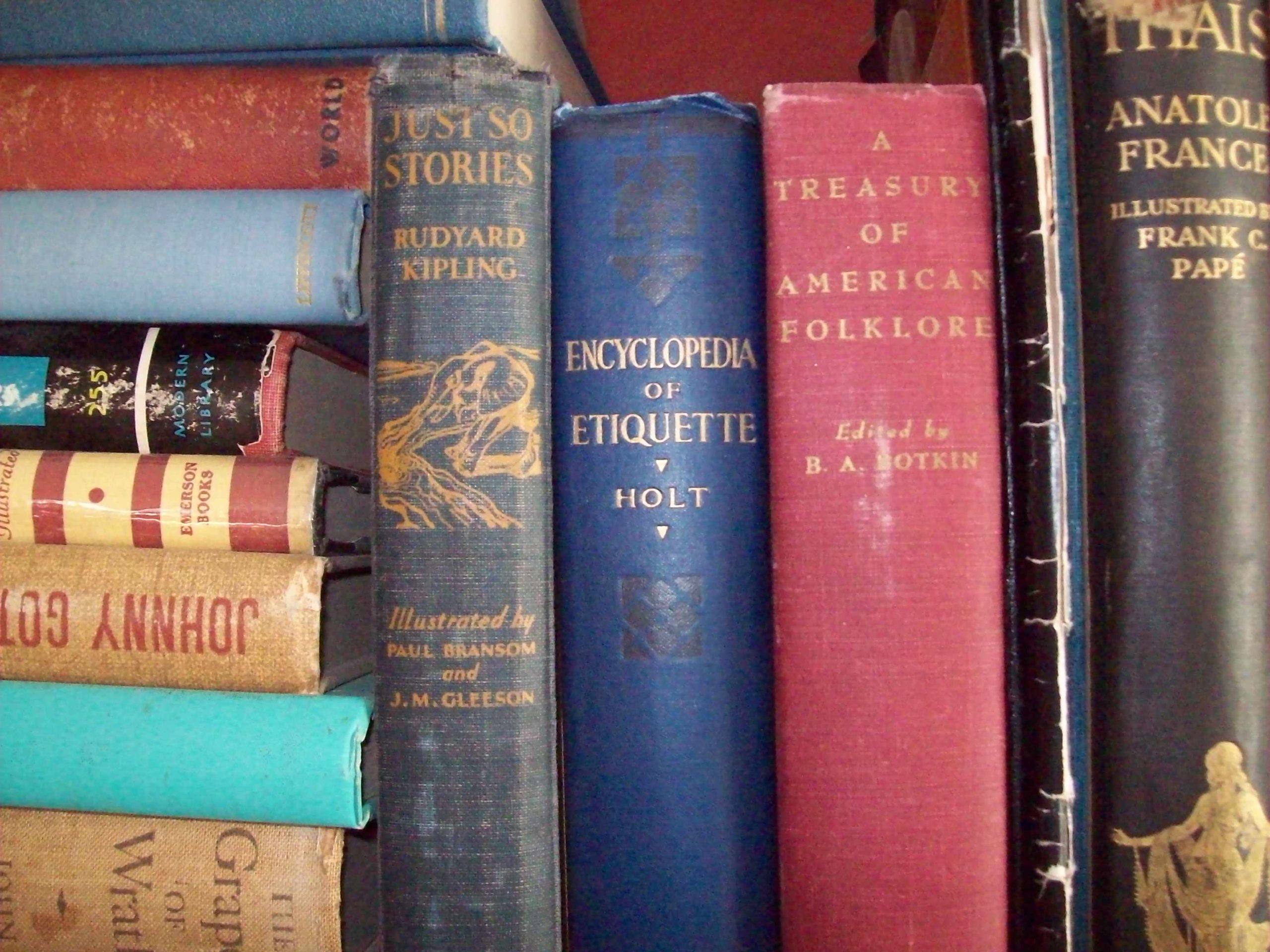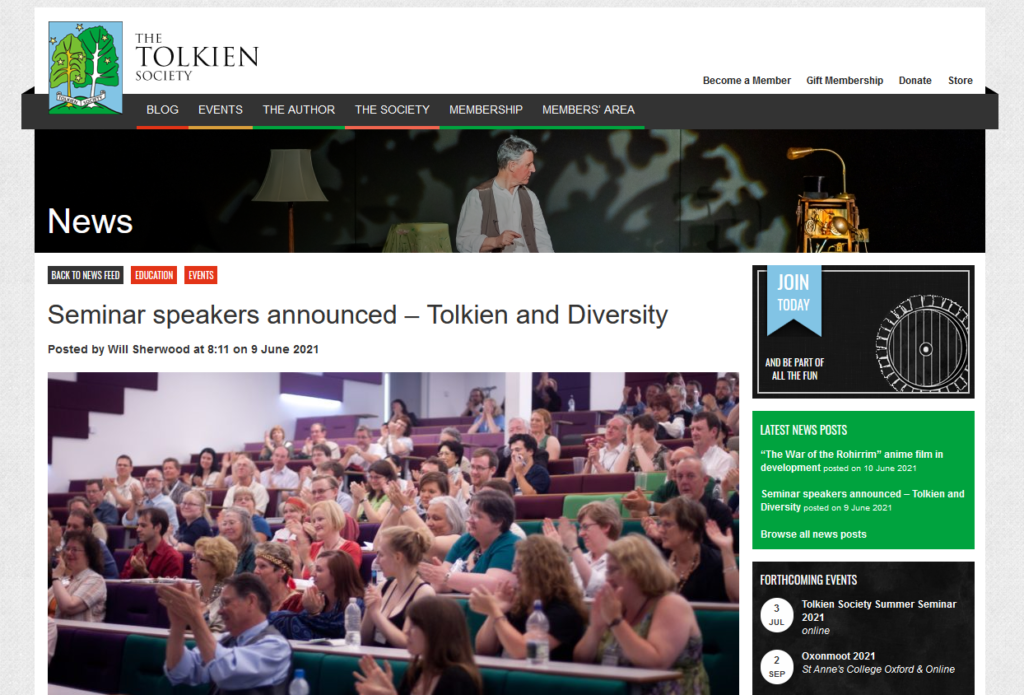Tolkien and Diversity: A Seminar Report

No Tolkien Society Seminar has ever attracted as much attention as the one held digitally on the weekend of July 3rd/4th. The announcement of “Tolkien and Diversity” was met with enthusiastic expressions of interest and equally enthusiastic tirades against the “wokeism” such a topic apparently expresses. Just before the conference efforts increased to discredit the seminar beforehand in comment sections, Twitter threads, blogs and vlogs, producing some politely worded (but, it turns out, largely unwarranted) condemnations of the Tolkien Society and its yet-to-be-held Seminar and a sad and deplorable cornucopia of racism, sexism, transphobia and hate speech, mostly in the aforementioned comment sections.
Some recurring concerns were: the Society might provide a forum to promote hatred of Tolkien(‘s works), presumably for him/it not being inclusive enough, a concern referred to as subjecting Tolkien(‘s works) to a leftist/woke agenda. It was feared that the papers would deny Tolkien’s Catholicism and the influence it had on his works or that the papers might twist and abuse Tolkien’s works by forcing woke interpretations on it.
Those concerned critics can rest assured: their fears were unfounded. They should perhaps have awaited the actual conference instead of letting their fearful fantasies run wild and construct the vision of a hateful and destructive seminar that they could then mock and criticize. What happened instead was a weekend of scholarly Tolkien fans presenting stories of how they or the groups of people they did research on approached Tolkien, appreciated Tolkien and found (reflections of) themselves in his work. A perceived lack of inclusivity was mentioned frequently but never overpowered the shared love for the Professor’s works. The papers were all highly informative and thought-provoking, but do not take my word for it. Check them out yourself, as soon as recordings are available on YouTube and LunaPress Publishing have the proceedings ready.
Not even the most extensive report can do justice to all papers, so I will provide only brief overviews, saying some more on the most ‘scandalous’ papers.
Cordeliah Logsdon’s paper “Gondor in Transition: A Brief Introduction to Transgender Realities in The Lord of the Rings” proved a very strong start to the Seminar. Cordeliah described LotR as a text of many contradictions, just like the Tolkienian eucatastrophe is itself a concept that relies on contradictions: joy, all the greater because it grows out of despair. Such contradictions resonate with the transgender community who themselves are often pressed into categories contradicting their self-knowledge. Cordeliah then demonstrated how Denethor is a character of such contradictions: comparing Eowyn’s “cage”-dialogue from “The Passing of the Grey Company” and Denethor’s speech from “The Pyre of Denethor” reveals clear parallels between the two and a closer examination of Denethor and Finduilas, as well as Gandalf’s many errors concerning Denethor, supported the observation that the text presents Denethor as stretching traditional gendered expectations.
Clare Moore continued with a paper on “The Problem of Pain: Portraying Physical Disability in the Fantasy of J.R.R. Tolkien”. She compared different treatments of wounded characters across Tolkien’s works such as Maedhros, Beren, Morgoth and Frodo whose wounds are sometimes described in detail, while with others the focus is more on the consequences: are they disabling, an impairment or relatively minor? In some cases – Frodo especially – the wound has physical and spiritual repercussions long after the event.
The third paper, Elizabeth King on “’The Burnt Hand Teaches Most About Fire’: Applying Traumatic Stress and Ecological Frameworks to Narratives of Displacement and Resettlement Across Cultures in Tolkien’s Middle-earth”, focused on the consequences of traumatic experiences and how they shape the lives of displaced people across the Legendarium. The Elves, a long-lived, migratory people posed interesting questions of inter-generational trauma and how this shapes the retained memory of a people. Elrond and Elros exemplified two different approaches to dealing with trauma.
I could only follow parts of Dr. Sara Brown’s much-praised paper on “The Invisible Other: Tolkien’s Dwarf-Women and the ‘Feminine Lack’” due to connectivity issues but she used the theories of Simone de Beauvoir and others to describe female Dwarves as the invisible Other and demonstrated how the long established mechanisms of marginalisation are at work here.
Sultana Raza next spoke on “Projecting Indian Myths, Culture and History onto Tolkien’s Worlds” raising the question of similarities to the Ramayana and Mahabharata, two Indian national epics, and in how far Tolkien might have been influenced by these epics. She concluded that while he certainly knew of the texts, it is not clear, how detailed his knowledge of them was.
In “The Lossoth: Indigeneity, Identity, and Antiracism” Nicholas Birns took a closer look at the indigenous people that were clearly inspired by Inuit, Sami or Nenets peoples. He painted a detailed picture of how considering the narrative from the viewpoint of a people from the margins can not only enrich our reading of The Lord of the Rings, but also actively encourage the readers’ anti-racist outlook by pointing out the role, non-Eurocentric peoples played in the history of Middle-earth.
Kristine Larsen – “The Problematic Perimeters of Elrond Half-elven and Ronald English-Catholic” – started with Tolkien’s own assertion that he was essentially a hobbit, demonstrating how and why he might have felt particularly drawn to ‘the little guy’. She then went on to point out extensive parallels between Elrond’s and Tolkien’s own biography: Losing their fathers at age 4, growing up as orphans with foster-parents and having to find their own home, also both following their own mothers when deciding to be/remain Catholic/Elven. Could Tolkien’s sympathy for Elrond’s life circumstances have led him to spare Celebrian, Kristine asked?
Cami Agan’s “Hearkening to the Other: Athrabeth Finrod ah Andreth” rounded off the first day of the seminar. In listening to, critically engaging with and actually learning from Andreth, a woman and mortal human in this curious philosophical dialogue, Finrod gains a new perspective, beyond the scope of his usual frame of reference. It is exactly this engaging with the Other, perhaps seemingly less worthy, that enables this learning experience for Finrod.

The second day started with Christopher Vaccaro’s paper “Pardoning Saruman?: The Queer in Tolkien’s The Lord of the Rings”, a title that had attracted much ridicule beforehand. Pardoning Saruman comes from Tolkien’s early drafts which included a Saruman willing or able to accept redemption. Christopher demonstrated however, making use of his extensive knowledge of Tolkien’s Christian Neoplatonism and Alain de Lille, how many of Saruman’s faults are associated with concepts traditionally surrounding sinful practices, first and foremost sodomy. This then constitutes Saruman’s queerness and no suggestion was made that Tolkien would have wanted to pardon him for that.
Sonali Chunodkar continued with her paper “Desire of the Ring: An Indian Academic’s Adventures in her Quest for the Perilous Realm”. A lack of translations into most local languages, Indian attitudes towards foreign-language literature and a cultural distance that lets the average Indian reader wonder, for example, which Tolkienian plant might be real and which just an invention, all provide hurdles to accessing Tolkien. That he is nonetheless much loved is not just due to the mention of Sam’s brownness, a description that’s even more surprising considering Frodo’s presumed lack of a tan in spite of his open-air roaming of the Shire for nearly two decades before the ring quest.
Robin Reid’s paper “Queer Atheists, Agnostics, and Animists, Oh, My!” focused on the distinction between intent and meaning set out in Verlyn Flieger’s seminal essay “But What Did He Really Mean?” before turning into a detailed presentation of the diversity unearthed in her survey of Tolkien readers which she illustrated with a well-structured handout that showed what a treasure trove of data and personal accounts her survey is.
Joel Merriner spoke on “Hidden Visions: Iconographies of Alterity in Soviet Bloc Illustrations for The Lord of the Rings,” a paper which introduced many visuals that seemed un-Tolkienian at first with their lack of conformity to a certain pseudo-medieval aesthetic. Joel also put them into context, demonstrating some of the Soviet cultural, political and social issues that might have inspired this particular type of depiction.
The fifth paper on Sunday was Eric Reinder’s “Questions of Caste in The Lord of the Rings and its Multiple Chinese Translations”. Having presented Chinese conceptions of foreignness and ‘Chineseness’ throughout history and the influence of European colonizers, he then demonstrated current Chinese attitudes towards racism by discussing Chinese reactions on social media to things like the possibility of Black Elves in the new Amazon series. He finished with a comparison of how different Chinese translations treated the “slant eyes” and “sallow skin” in LotR and how these potentially problematic phrases were dealt with.
Dawn Walls-Thumma’s paper “Stars Less Strange: An Analysis of Fanfiction and Representation within the Tolkien Fan Community” posited that Tolkien’s ability to hint at hidden realities in his texts without explaining them fully might enable writers to more easily include characters or plot-lines that resonate with members of marginalized communities mostly absent in the original works. That such stories often face heavy backlash by self-proclaimed gatekeepers of the fandom, using ‘canon’ as an argument, is all the more absurd.
In the penultimate paper, by Danna Petersen-Deeprose, on “’Something Mighty Queer’: Destabilizing Cishetero Amatonormativity in the Works of Tolkien”, Danna defined the words that will have triggered the attention beforehand and then demonstrated how many of the relationships between characters in LotR fall outside the traditional ‘man and woman love each other and raise children’. The adopted Frodo not only lives together with his bachelor uncle (no sexual intimacy implied!) but also shares “nongenital tactile tenderness” on their journey and later his house with Sam’s young family, before Sam eventually follows his old master into the West. Legolas and Gimli, the latter also leaving Middle-earth with his companion are another pair that defies traditional norms, whether one assumes they were more than friends or not. Danna even identifies the perpetually beardless androgynous hobbits and the openly gender-fluid Ainur as creations of Tolkien who transcend traditional gender-roles, also pointing out how Merry and Eowyn are both called men, while not self-identifying as such. Danna’s conclusion is clear and supported by a wealth of evidence: In Tolkien’s texts, cishetero amatonormativity is not the norm.
Martha Celis-Mendoza’s paper “Translation as a means of representation and diversity in Tolkien’s scholarship and fandom” ended the conference by giving an account that drew on the many facets of her Mexican, Spanish-speaking context. Not translating Spanish scholarly texts into English and vice versa not only limits the spread of insights but also isolates different languages and cultures even further from thought processes abroad. The recently translated “Uncle Curro” on Father Francis Morgan by José Manuel Ferrández Bru at Luna Press Publishing and the upcoming “Law, Government and Society in JRR Tolkien’s works“ by José María Miranda Boto in the Cormare Series are laudable exceptions I would like to mention here.
Picture credits: “Books” by amidfallenleaves is marked with CC0 1.0
